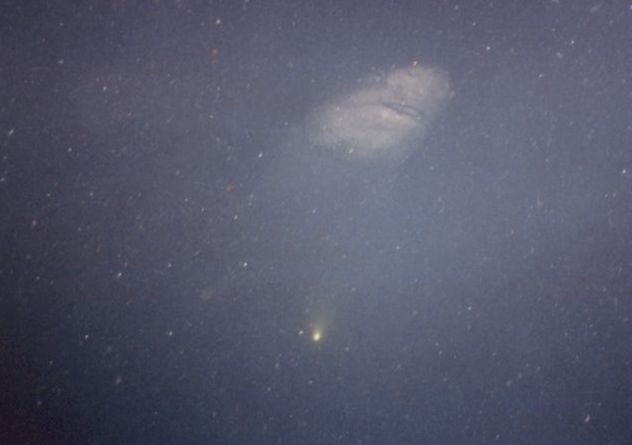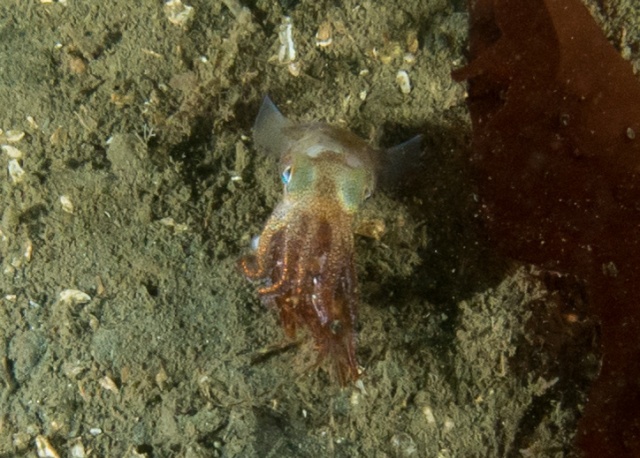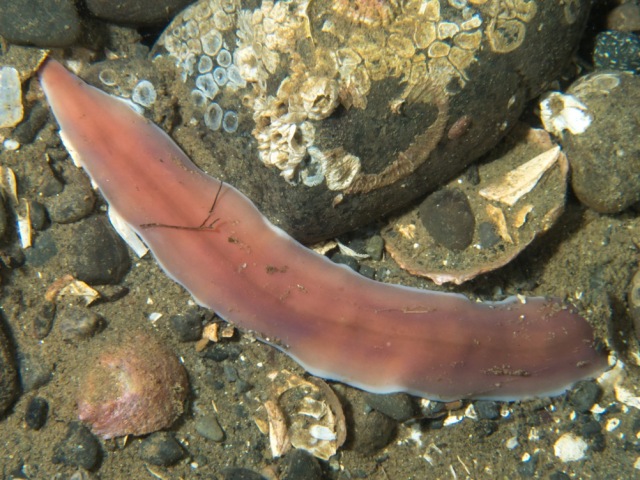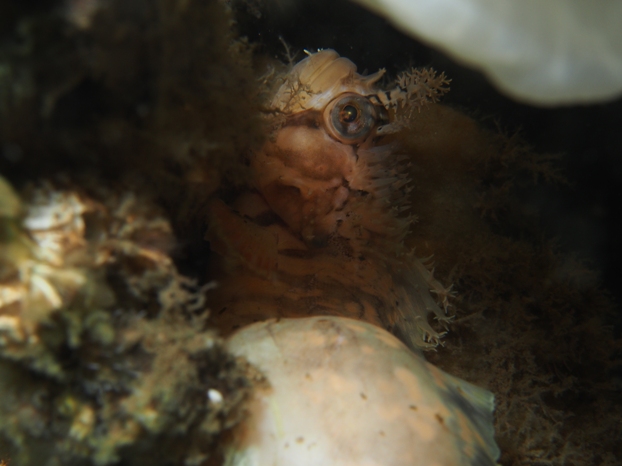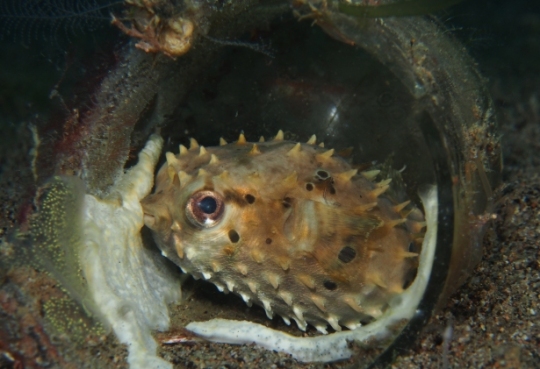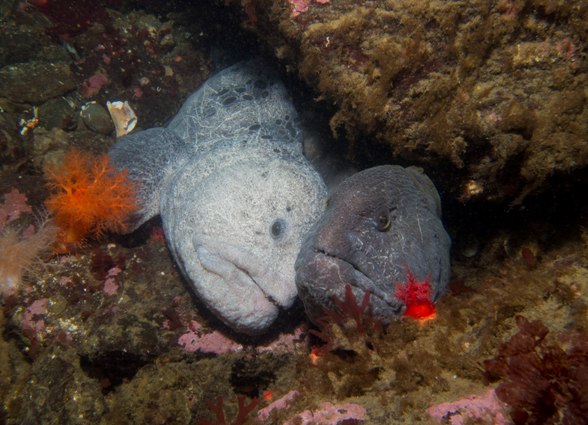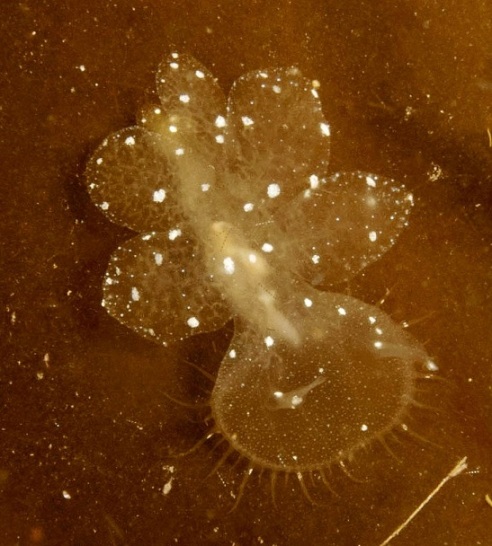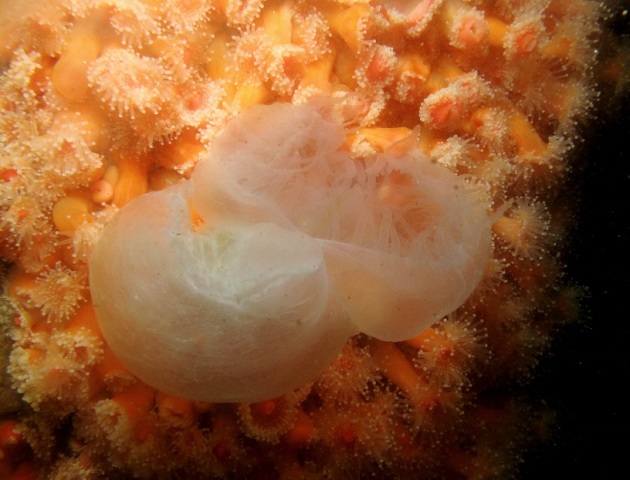This is one of those “best-kept secrets” that will be all the rage by next year, I’m pretty certain. I’m referring to snorkeling with sailfish outside of Isla Mujeres, Mexico.
I was there in February, and on my return I wrote an article for my dive club’s newsletter, but if you weren’t in my dive club you probably didn’t see the newsletter. I recently posted a photo of me in the water with the sailfish taken by one of the photo pros on our trip, and I got a lot of questions. So I thought I would reproduce the newsletter here on my blog site. But first, a few thoughts that did not make it into that article.

Yours truly, sailfish’s perspective. Fortunately I bear no resemblance to a sardine. Photo by Britta Siegers.
The Atlantic sailfish show up in winter in the waters off Isla Mujeres because during this season down in deep water there are millions of sardines — tasty treats for these arguably world’s-fastest-fish. And after being in the water with the sailfish, I can tell you with complete confidence that if you don’t look like a sardine, they don’t really care about you at all. But if you are a sardine and you are unlucky enough to end up in one of these herded “baitballs,” your minutes are numbered. The baitballs are consumed sardine by sardine by a group of sailfish, until the round school of little prey fish are completely gone. Poof.
One of the scenes I found endlessly fascinating was watching the sailfish catch and eat the sardines. There were moments when I could hear the crunching of bones in the water. And the first time my eye caught sight of a lone sardine that had somehow got separated from the rest of the baitball, I was shocked to witness a sailfish appear out of nowhere at the speed of light and — BAM — no more lone sardine. I learned quickly then that any time a sardine was singled out from the group, it was easy pickins and would last no more than a few seconds.
Which is exactly why from that moment on whenever I saw a lone sardine, I watched it, because I knew what was about to happen. (Same reason people stare at car wrecks? I dunno.) And, it’s also why I had a little freak-out moment of my own at one point.
We were floating on the surface after the action had passed but before the boat had retrieved us, and I felt something tickling my back. I thought it was my imagination at first. But it happened a second time and I couldn’t ignore it again, so I looked over my shoulder to discover a sardine. On me. Doing something fish don’t usually do: trying to get out of the water. By getting on me.
Instantly I thought of the needle-sharp nose of some still-hungry sailfish that I was sure was going to appear out of nowhere to spear the little fish on my back. You bet I did a strange horizontal water dance to get out from under that little small of prey otherwise known as a target.
Call me a coward, but far be it from me to come between a Fish and its Dinner.

Below is the reproduction of the article I wrote for my dive club’s newsletter: Marker Buoy’s Buoy Tender, for the March 2014 issue.
Lessons Learned while Swimming with and Photographing Sailfish
I will admit that when I first heard of snorkeling with sailfish, my response was less than enthusiastic. First of all, snorkeling? But I’m a diver… Second, when I saw the photos others have taken from similar trips, I thought they were fine and nice but they did not particularly grab me. And yet, I wanted to go on this trip, and after all the raves I’d heard of from others who have been in the water with arguably the ocean’s fastest fish, I knew it would probably exceed my expectations.
I was very correct.
Sailfish, which are in the marlin family, are in the open ocean about an hour’s boat ride from Isla Mujeres every year from January through March, roughly. They are there because the sardines are there. And I won’t spend too much time belaboring those details here, because I want to save the rest of my column space to focus on the challenge of capturing these super-speedy fish in photos.
About a week before I was to fly, the travel agent said scuba might be available, but if so we’d dive with a backplate they would provide, because a normal BC had too much drag in the water. Um. If a BC has too much drag, what about my camera strobes? Turns out, you don’t use them. Not normally anyway.
I have been swimming weekly, and I went to the pool two last times between her foreboding warning about swimming hard and my flight to Cancun. Both times I put on my zoomers and did some hard workouts. I do not regret that one bit.
When we arrived, they told us no one had been seeing sailfish, so there were no guarantees. They were quite serious, and we believed them, gravely. We understood we might spend four days in a boat with nothing to show for it but extreme facial and hand tans (the rest of us covered in neoprene).
The best lighting conditions we encountered were on the first day. The best everything conditions were on the first day. We got so lucky that Saturday. The water was flat calm, the sun was shining, the water was clear blue. Which is why we were so easily able to spot three whale sharks that day. By the time we saw the third one, we kept going – we ignored it. That’s how much in the animals we were. We saw long trains of mobula mantas swim by. We also got in the water with manta rays that calm day. Again, later that morning we motored past many mantas, only stop-ping to get in the water when we found a group of four together – like the third whale shark, solitary mantas had become a low-value target.
The professional photographers on board got mind-blowing photos of everything – mantas with their accompanying remoras and massive shoals of sardines. Whale sharks feeding at the surface with glorious rays of sun shooting through the water.
My photos are so amateur it is actually physically painful for me to review them in comparison to the pro’s images.
Each day, the weather got progressively stronger. Our second day was chock-full of sailfish. On the third day we had to motor for a few hours before we saw any signs of life in the choppy seas. The first animal we found that day was a whale shark. That was a fun one for me, as I was absolutely loaded with adrenaline and swam harder than I probably ever have in my life to stay with the animal as long as I could. After the whale shark, we found more sailfish, and on the fourth day, the dolphins were not only visible from the surface, but we were able to spend some precious moments in the water with them as well. In fact, no joke, I actually witnessed one doing that “ack-ack-ack-ack-ack” call while swimming directly towards me underwater. I didn’t know they could even make that sound when they aren’t dancing backwards across the water like Flipper.
Before the trip, I thought four days doing the exact same thing sounded sketchy. Me, ever the skeptic. But by the fourth day, I was only just beginning to get my camera to play nicely with its master. One time, I dropped in a spectacular position with the sailfish, and they were zipping past me all over the place. I felt like I was in the middle of a sport fisher reality show. But every photo was so blurry, no matter how long I held the focus button. I checked and checked and checked my settings, and eventually discovered that upon splashing from the boat, my macro knob had been turned on. And, these fish are not macro – that much I know.
So I thought I might offer a few tips to the amateurs like me – things I learned – so if you do this trip, you can save yourself a big portion of the learning curve.
My recommendations.
This sport is not for everyone. Unlike diving, where if you’re doing it right, you are not working very hard, you have to be prepared to drop in the water at a moment’s notice and swim like hell for as long as it takes. These are amazing interval workouts. So, be a very strong fin-kick swim-mer.
Take extra snacks. The sandwiches they provide on the boats get very old very fast.
Shop around for a good operator, and if possible organize your own group. We used EcoColors, and they were fantastic. We also paid extra to have fewer people on the boat. Do that too.
I was in a 3mm wetsuit all day, every day, and that was perfect. The wind gets chilly while motoring around, and the neoprene provided a nice windbreaker.
Do not expect to dive. It is rarely worth the trouble, and the bubbles only scare away the sailfish. We witnessed this time and again as divers from a different operator kept getting in the water with us, and as soon as they arrived, the sailfish were insti-gone.
Leave the strobes at the hotel until you get a good feel for what this is all about. Or, if you are really set up, take two systems, and on the rare occasion the bait ball is not moving, try your hand at flash photography.
When the bait ball is stationary, we learned quickly that a bunch of snorkelers all in a bunch gives the sardines a big shady patch to shoal. Read: sailfish will leave the area. So move in and out and around, but don’t ball up in a big mass of humanity if you want the big fish to keep hunting.
Some “Notes to Self” that you might also benefit from.
Be sure to allow the camera to focus before snapping. Just firing rapidly in frenzied excitement is not a good approach.
If you are using a GoPro, do not use any red or magenta filters; you are shallow enough that the natural light works just fine, and any filters will cast a strange tint to the water reminiscent of a wet hell.
Bring and use sunscreen for face and hands and lip balm with a high SPF. My bigger failure was on the latter – I cooked my lips severely, and by the end of day two I looked like a red-lipped bat-fish. And this, people, is the wrong ocean for a red-lipped batfish.
Don’t scoff at four days doing the same thing. After four days, you will wish for four more, because maaaaaaaaybe at the end of four days you were just starting to get things figured out.

Atlantic sailfish (Istiophorus albicans). The white flecks in the water are scales from the sardines, which are now in the bellies of the sailfish. These glittering remains were always a tell-tale sign of where a feeding frenzy had taken place, and often nothing was left in a big patch of blue water except the scales as the sailfish (and the sardines with them) had long since moved on.

This is one of the larger baitballs we saw, as its numbers had not yet been decimated by the feeding sailfish. The larger sardine balls would sometimes split in two and converge again after a sailfish swam through it — much like flocks of shorebirds flying in unison. If a single sardine somehow got singled out away from the rest of the bait ball, that sardine just signed his death certificate — without exception, a lone sardine lasted only seconds near these sailfish.



We lost count of how many manta rays were out on the first day. They were easily spotted from the boat from their wing tips extending above the water.

On the first day, the whale sharks were easily spotted feeding along the surface of the water. This particular whale shark was the only one we spotted after that first day, as seas had become increasingly rougher. That, and it was not actually “whale shark season.”









